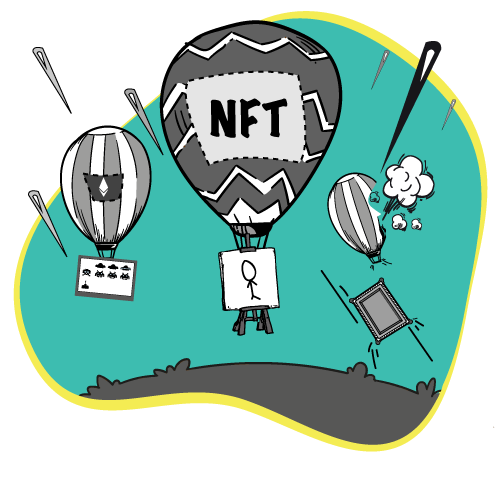Non-Fungible Tokens: Redefining the sector of Digital Art through Blockchain Technology

With the incessant rise in the upliftment of Blockchain technology (a digital ledger of transactions) and especially cryptocurrency, the market dynamics have become quite volatile. As more people are inquisitive to understand the fundamentals of cryptocurrency and are looking for options to invest in this field, the capital influx has hit an all-time high in quarter One of 2021.1 Seemingly, Cryptocurrency is a form of digital currency that works through Blockchain technology which in turn is a technology providing a decentralized network for dealing with transactions eliminating the role of state institutions like banks. This currency can be used to exchange/trade for goods and services and is also often called as tokens. Moreover, these tokens are fungible in nature because they are mutually interchangeable and all tokens possess the same value which means that even if the tokens are exchanged, the monetary value will still remain the same.
Unlike Fungible Tokens, the concept of Non-Fungible Tokens (NFT) has also been seen as setting up a new trend. NFT is basically a class of Cryptocurrency Tokens which are unique in nature and cannot be interchanged as each token has its own exclusive properties. So, it can be deduced that the purpose of NFTs is not to be used as currencies but to be used for different other things. One purpose for which NFTs have been seen using is the promotion of trade in digital art. As NFTs have the capability of acting as a certificate of ownership, the global audience is showing interest in acquiring ownership over different digital objects. Thus, with the features of Blockchain technology making it globally operational and having the feature of creating records of ownership on digital ledgers, NFTs are redefining the concept of buying and selling of the digital by making people show white-hot enthusiasm to acquire such tokens.
Global understanding of NFTs
Currently, NFTs are seen as a step towards revolutionizing the hobby of digital fine art collecting. Digital art can be understood as those artistic creations in which digital technology has played a significant role including computer art and multimedia art. Till the time, digital art was never much incentivizing as it is today. Earlier, the concept of collecting traditional art was the only essence of glamorizing this hobby of the collection, however; such a process was cumbersome and was limited to few people. With the idea of eulogizing the collecting digital art, NFTs have made the process less tiresome and has made easily accessible for all.
To describe the market of NFTs at present, one can see the example of Beeple who is a digital artist who has sold an NFT of his work for $69 million at Christie’s. Before NFTs, he faced difficulties in even selling a print for a value of $100.2 Similarly, one of the tweets of Elon Musk was auctioned on NFT platforms in which the highest bid was over $1.12 million; however, Elon Musk refused to sell his tweet.3 Therefore, the feature of monetary incentivizing digital art has seen a great head start through NFTs. Not only NFTs would focus on the trading aspect, but rather it would also motivate the artists to produce more qualitative art pieces so that the consumers could bid for the purchase. So, the digital art which was undervalued will now be able to create financial value for the artists.
However, the digital revolution would be a favourable move, nonetheless, the issues related to Intellectual Property Rights and Contractual obligations will increase manifold times. It is due to the large rate of piracy and plagiarism prevailing already on the digital platforms. The problem would occur when a person purchases an NFT and becomes the owner of the same, the person would like to enjoy the exclusive possession of the same, however, due to fraudulent activities prevailing in a digital world, the digital files could be readily reproduced, making it difficult to recognize the ‘digital first sale’ doctrine under IPR for the NFTs. Moreover, it also has to be seen that the ownership only remains to the extent of the token which means that the consumer will enjoy exclusive possession over the token purchased only and not on the whole article in reality. For example, if a person purchases NFT which includes a copy of a digital book, the person would have the possession limited to the copy of that digital book but would not enjoy the ownership of the copyright in the underlying novel.4 These points could make a consumer less interested to deal with NFTs if seen from the view of an art collector.
NFTs knocking on the doors of India
It has been observed that NFTs are now prevailing in India as well. India’s biggest cryptocurrency exchange by volume, WazirX, has launched the country’s first marketplace for NFTs. Through this, now the Indian digital art creators can sell their art by auctioning it over the NFT marketplace. Also, it will provide room for the buyers to purchase NFTs. It can, therefore, promote the ecosystem of digital art in India.
Nonetheless, it is a little difficult to predict the future of NFTs in India seeing the Government’s displeased response to cryptocurrencies like Bitcoins, etc with an intent to ban the same in India5 citing a threat to security because of the potential of financing illegitimate activities. Currently, no separate and exclusive legal framework are provided for cryptocurrencies in India. Although, in 2018 Reserve Bank of India did try to ban such activities but the Supreme Court in 20206 held such a move to be unjustified. The issue however becomes more complicated when it comes to NFTs as it is essential to see the nature of these tokens. If these NFTs are seen as derivatives, then as per the Securities Contract Regulation Act, 1956, such derivatives are not legally allowed to be an exchange, trade, sell or buy.7 Seen from a creator’s viewpoint, NFTs must be seen differently from cryptocurrencies as the former has much potential to reward the creators in India, but it cannot be ruled out that NFTs do require a proper framework that could help them to be regulated and also has a long term strategy to deal with NFTs properly.
Conclusion
Undoubtedly, the NFTs is a headstart and may assure new dynamics in the field of digital art as well as Blockchain technology. However, at the same time, it is necessary that the law should not lag and may remain a step ahead of the developing technologies. It is essential because with the joy of new inventions, fear of legal complications increases. Similarly, with NFTs acting as a thrust to the market of digital art, risks such as piracy are already on its shores. Therefore, suitable state-specific, as well as transboundary laws, are required to keep checks and balances on the functioning of NFTs.
At the same time, it is also necessary to ensure that the market of NFTs does not turn out to be a mode of committing financial offenses like money laundering, hawala, etc. NFTs being decentralised in nature can risk the tenets of the financial system through transferring proceeds of crime through these platforms so that the transactions remain camouflaged from the government machinery. Apparently, the estimated market of NFTs cannot be deduced at present because the government of each state has not commented on this openly. Unlike cryptocurrencies which are prohibited in some countries, the faith of NFTs at present remains in a dilemma as to whether it would be allowed to function liberally or it would be banned from functioning.
References

